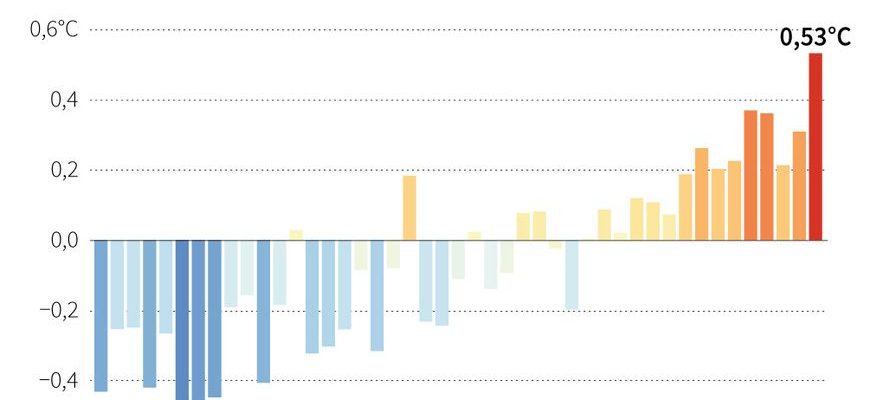The records follow one another and – more worryingly – look alike. The world experienced its hottest month of June on record, announced on Thursday July 6 theeuropean copernicus observatory. The summer of 2023 could be extraordinary: the combined effect of climate change and the return of the El Niño phenomenon are pushing temperatures in the oceans and on land to levels never before recorded. The global thermometer rose to 16.51°C in June, 0.53°C above the average for the past three decades. The previous record, in June 2019, was “only” 0.37 ° C above these normals.
Thursday, June 22, the Chinese capital had experienced its hottest June day since records began. This is half a degree above the station’s monthly record of 40.6°C recorded in June 1961, and ranks behind the 41.9°C recorded in July 1999. Spain and the United Kingdom also experienced record heat. Across the Channel, the average temperature in June reached 15.8 ° C, 0.9 ° C more than the previous record of 14.9 ° C observed in June 1940 and June 1976, detailed the Met Office, the UK National Weather Service.
But the hottest day ever measured globally was recorded on Tuesday July 4, 2023, largely beating the record set… the day before. This is indicated by the preliminary measurements unveiled on Wednesday July 5 by an American meteorological observatory. On July 4, the average air temperature on the surface of the planet was measured at 17.18°C by an organization dependent on the American Agency for Oceanic and Atmospheric Observation (NOAA), which however did not not yet given official confirmation for this day. This measurement clearly exceeds the 17.01°C recorded on July 3 and which already beat, by a significant margin, the previous daily record (16.92°C) established on August 14, 2016, and repeated on July 24, 2022.
The overheating of the oceans, under the effect of climate change and the return of the El Nino phenomenon, led this year to a record for the average global temperature for less than June, announced Thursday the European observatory Copernicus.
© / AFP
Heatwave in the Atlantic
“The June 2023 record is largely due to very high ocean surface temperatures”, which make up 70% of the globe’s surface, C3S scientist Julien Nicolas told AFP. On May 23, the data recorded by the Climate Change Institute from the University of Maine had shown that the temperatures on the surface of the Earth and the oceans had reached a maximum never observed for the month of May. Another peak. Between March and May 2023, the average temperature at the surface of the oceans reached an all-time high in 174 years of measurements, exceeding the average of the 20th century by 0.83°C, according to the data from NOAA. The threshold of 21.1°C has been crossed, according to data from the American observatory NOAA. More serious: the temperature has remained at this level for forty-two days in a row.
An unprecedented heat wave has hit the oceans and in particular the waters of the Atlantic. Half of the world’s oceans could experience some form of marine heat wave by the end of summer, NOAA has warned, based on an experimental forecast system. For example, the Atlantic Ocean experienced a temperature rise of +3 to +5 degrees, on average, in June.
The warming of the oceans is worrying in more than one way, because they serve to mitigate the effects of human activities on the climate. How ? Like a sponge, “the ocean has absorbed more than 90% of the increase in heat caused by human activities”, CNRS oceanologist Jean-Baptiste Sallée told AFP. Its warming is causing “unprecedented cascading effects”, underlines the UN, such as melting ice, rising sea levels, ocean heat waves and ocean acidification. Thus, scientists fear that the capacity of the marine environment to absorb these excesses is reaching its limit.
On their side, the glaciers are melting at a spectacular speed. The Antarctic sea ice reached its lowest level at the end of February, marking a melting record since satellite measurements began 45 years ago, the American National Snow and Ice Data Center (NSIDC) announced on Monday February 27. . The sea ice had “probably reached its minimum extent for the year, at 1.79 million square kilometers, on February 21, 2023,” the observatory said.
Record drought in France
To the australian radio abc, on May 24, scientists said they had observed a “rapid and breathtaking reduction” in the amount of sea ice in Antarctica, describing the decline as “appalling”. For its part, the Arctic could be deprived of sea ice in summer as early as the 2030s, researchers warned on June 6 in the journal NatureCommunications. Much earlier than what was expected by scientists.
Finally, there is also drought, which is recording levels never before reached. In France, the rain did not fall for 32 consecutive days. Unheard of for all months since the start of recordings in 1959, beating the – sad – record that of the year 2020 between March 17 and April 16 (31 days). Since the end of 2020, the countries of the Greater Horn of Africa (Ethiopia, Eritrea, Somalia, Djibouti, Kenya and Sudan), a large peninsula in the east of the continent, have been suffering the brunt of their worst drought in the past forty years.
